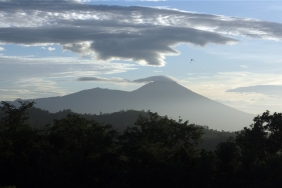COMPREHENSIVE EFFORTS ARE NEEDED TO PRESERVE BORNEO
Borneo has long been famous for its natural beauty and its extremely rich diversity of ecosystems, representing much of the world’s flora and fauna. Many amazing species, such as the proboscis monkey, are found only in Borneo and nowhere else in the world.
Borneo was described by many early naturalists as a paradise of biological wonder. This is still mostly true nowadays, but the biological wonders are facing serious challenges.
Borneo’s forests and ecosystems are succumbing to the economic and social pressures of life in the 21st century. Many of these pressures are familiar: clearance for industrial agriculture, unsustainable logging and mining - as countries strive to develop their natural resource base.
The latest assessment of the environmental status of Borneo by WWF, which was recently published, reveals that the effects of these pressures will have grave consequences if the current trends of economic development of the island continue unchanged.
Borneo is in danger of losing its major ecosystems and the valuable eco-services they provide which are critical to the long-term survival of local communities and the economies of Indonesia, Malaysia and Brunei Darussalam.
It is still possible to stop the degradation of the island’s critical ecosystems but the three Borneo governments need to double their efforts to protect biodiversity and livelihood opportunities.
Worrying situation
Borneo’s forests continue to decline. Historical forest cover at the turn of the 20th century was 96% of the island but by 2016, this had fallen to little more than half the island, and part of the remaining forests are degraded.
This rate of decline is uneven across the ecosystems. Freshwater swamp forest, home to many unique wetland species but also much favored for conversion into fertile agricultural land, is gradually disappearing with less than one-quarter of the original extent left in 2016. Heath forest has also been strongly reduced in area.
By total area, lowland forest - a critical habitat for the conservation of many globally endangered species - is by far the most converted ecosystem type in Borneo. Ease of access for palm oil production and agriculture has made it one of the most endangered habitats on earth.
Similarly, unique species are in rapid decline, or face an uncertain future. The orangutan, elephant and proboscis monkey for instance have lost half their distribution area due to large scale forest disturbance and conversion.
Some good news
Two of the main ecosystems of Borneo are still doing well and have not been subject to mass conversion. The upland rainforests and montane forests of Borneo grow at higher elevations and do not suffer high rates of deforestation, with nearly 90% of the historical coverage still remaining.
Indeed, the area known as the Heart of Borneo has fared far better than the lowlands and coastal areas. This highlights the forethought and relative success of the three Borneo Member Countries’ 2007 historic Declaration to conserve the Heart of Borneo (HoB) area of 23 million in the centre of the island.
With 2017 being the 10th anniversary of the HoB Declaration, the 2016 assessment findings may provide the impetus for a renewed focus on Borneo’s environmental issues. A new focus is needed because, if action is not taken, the projections in the assessment reveal a potentially critical environment regarding the future of the island’s stunning biodiversity.
The critical environment
The assessment revealed that it is almost too late for some ecosystems in Borneo. Without unprecedented, concerted and large-scale efforts in restoration, reforestation and protection, the majority of the original ecosystems will continue to decline to critical levels.
According to projections in the assessment, if the 2005-2016 deforestation rates continue under a business-as-usual scenario, a further 6 million ha of forest may be deforested until 2020.
The largest projected deforestation will occur in lowland rainforest and swamp forest, but deforestation rates in other ecosystems will also be unsustainably high. This will affect the fate of many endangered species.
Threats
As part of the analysis, the assessment identified the developments and ‘threats’ currently facing Borneo’s ecosystems:
Fire: Fires are a major threat, particularly to peat swamp forests and lowland rainforests and especially at the edges of oil palm plantation areas, where their ‘accidental’ nature must be questioned as they pave the way for further development of the existing plantations.
Land conversion: Expansion of oil palm and pulpwood plantations, sacrificing natural forests, are major factors in the continued deterioration of Bornean ecosystems.
Inadequate spatial planning: The lack of coordinated spatial planning has resulted in allocation of licenses into environmentally sensitive areas as well as habitats for species that include orangutans and elephants.
Spatial planning has in fact a huge role to play in moving away from Borneo’s business-as-usual model. The 2016 assessment revealed that more than 8 million hectares of forests have not yet been allocated to be retained for protection or sustainable timber production. This frequently implies that the forests can be cut down and converted.
Systematic spatial planning that balances nature conservation with sustainable development would do much to halt deforestation and biological degradation cross Borneo.
A way forward
There are many responses possible to the challenges ahead and the environmental status assessment also puts forward a number of recommendations.
Key amongst them are:
- Ensure ecological connectivity of the landscapes of Borneo through island-wide spatial planning for effective conservation of biodiversity and ecosystem services.
- Evaluate spatial planning per landscape to ensure adequate representation of all ecosystems and species habitats.
- Identify and establish a new baseline for all idle non-forest land, and consider it as the only alternative for new plantations.
- Develop monitoring systems and prescriptive action to ensure that all production forests remain under natural forest cover.
The three national governments of Borneo have shown their commitments to accomplish these key recommendations in the HoB. The preservation of the ecosystems and species can however only be achieved by taking the whole of Borneo into consideration. Comprehensive measures to ensure that economic developments are in balance with nature conservation need therefore span entire landscapes across Borneo.





